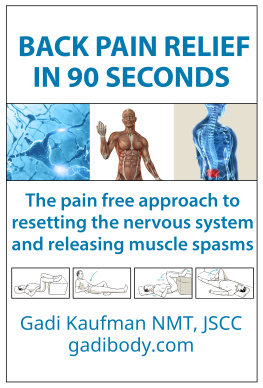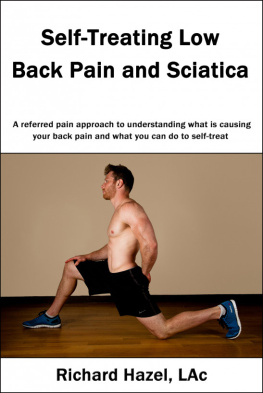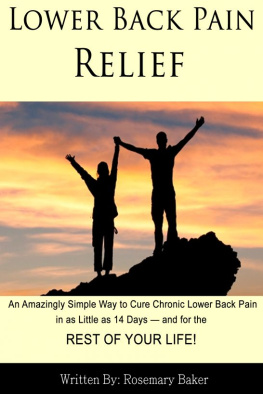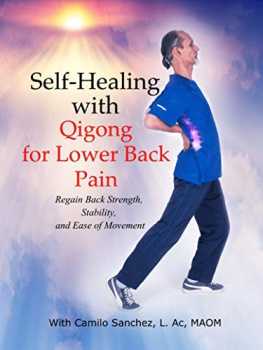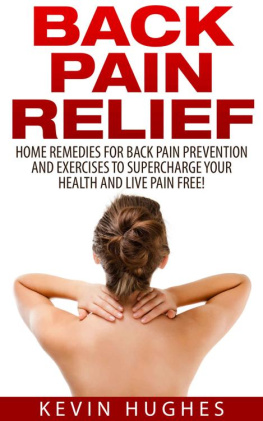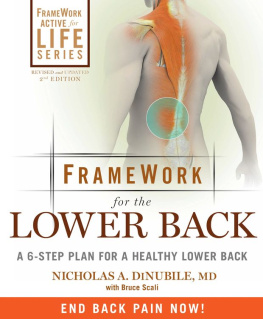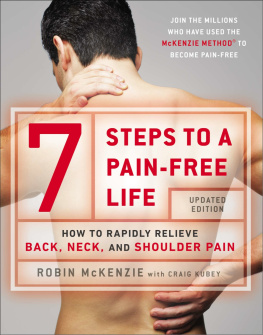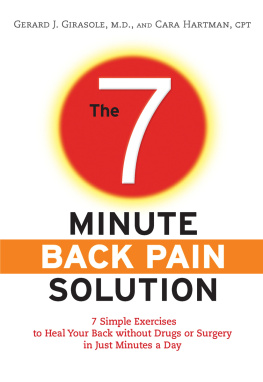Back Pain Relief
in Seconds
The pain-free approach
to resetting the nervous system and releasing muscle spasms
Gadi Kaufman NMT, JSCC
http://gadibody.com
Disclaimer
Copyright 2014 Gadi Kaufman, NMT, JSCC
ISBN: 978-0-9965664-1-4
LCCN: 2015911099
All rights reserved. No part of this book may be reproduced, distributed, or transmitted in any form or by any means, including photocopying, recording, or other electronic or mechanical methods, without the prior written permission of the publisher, except in the case of brief quotations embod- ied in critical reviews and certain other noncommercial uses permitted by copyright law.
Medical illustrations reprinted with permission by Wolters Kluwer Brown. From Travell & Simmons, Myofascial Pain and Dysfunction: The Trigger Point Manual Vol. and Vol. Copy- right 1998 and 1992 by Wolters Kluwer Brown.
Original Illustrations by Josh Evans
Design and Production by Derek Padula: // derekpadula.com
This book is intended to be a helpful reference, and not a replacement for the guidance, diagnosis, treatment, and care of your physician and other health and medical professionals. For concerns about any medical condition you may have, seek the advice of a trained medical professional. The author, publisher and all associated with the creation of this book are not liable for loss, injury or damages that may occur as a result of the informa- tion and images within this book.
For my wife Sandra and my son Ethan
The nervous system is the boss.
The muscles are the employees.
Contents
vii
Introduction
Introduction
Do you suffer from lower back pain? Is it so bad that you can no longer live a normal life? Does it hurt to get in and out of your car or to sit at the kitchen table? Is it difficult to change position in bed without pain? Or maybe you cant bend over to pick up your kids or a bag of groceries without wincing and grabbing your lower back. People tell you to exercise, but its too painful and you avoid walking long distances for fear of exacerbating the problem. Instead, you take every chance to lie on the floor in hopes of getting some momentary relief.
Youre not alone. Did you know that one out of four Amer- icans suffer from debilitating lower back pain?
The reason lower back pain is so common is that we live in a sedentary society. To say it simply: We sit too much. We sit in the car driving to work. We sit at the office all day because of the necessity of using a computer. Then we sit in the car driving back home. Once there, we sit at home watching television or grab a laptop and kick back into a chair. Sound familiar? All of this goes against the biomechanics of the human body. We are biomechanically designed to stand and walk, not to sit for so many hours a day.
Here in lies the dilemma for the back pain sufferer. To be healthier, you need to do more moving, walking and stand- ing. But if you have lower back pain, then moving, walking, and standing is not something you can do without crying out in pain.
So how do you find relief? As you know, there are many options out there today and surely youve tried them all: from pain medications to acupuncture, to chiropractic care, mas- sage, and physical therapy or even the last resort of surgery.
Maybe one of these methods has provided you with tem- porary relief for short periods of time. But did your relief last? Were you able to alleviate your pain long enough to return
viii
Back Pain Relief in seconds
to normal life and enjoy your daily activities?
What you dont know about lower back pain
Theres no question that these other practitioners have tried with good intentions to diminish your lower back pain. And if youve been to see a massage therapist or another specialist, what youve noticed is that the work they do in treatment is focused primarily on the part of your body that feels the painmeaning, your lower back. They go straight to the symptomatic area and massage muscles or insert tiny nee- dles. And that seems logical, right? Well, maybe not.
In this book, youre going to learn some very important information about lower back pain that you have not been told by other practitioners.
Did you know that the majority of lower back pain does not actually originate in the lower back muscles themselves? In other words, while you feel pain in your lower back, very often, the source of your discomfort can be traced to the front of the body. Yes, thats right: In most cases the source of lower back pain can be found in the front of the body, and it then radiates from there to the lower back.
There are several muscles in the abdomen and hip area that we use to sit, stand, and walk.
One of the most important is the iliopsoas muscle. This muscle attaches to the side and front of the lower spine. From there it continues down through the inside of the hip bone and connects to the top of the thigh bone on the inside.
Naturally, these muscles get tired from over-use. And when they do, a chain reaction occurs that spells trouble for you. This is what typically happens: When your worn-out and fatigued muscles can no longer function properly, they go through a process that puts them into a spastic state called a spasm. A spasm means they are locked in a shortened posi- tion and contracted to the point where they have lost their ability to lengthen. At the same time, the bodys nervous
ix
Introduction
system contributes by helping to put and keep a muscle in spasm indefinitely. And while in spasm, the muscles can twist and torque the spine, cause rotation of the pelvis in several directions (usually forward and to the side), and finally lead to compression of the thigh into the hip socket on one or both sides of the body. (For more details, visit gadibody.com and read the article Understanding Biomechanics.)
After all this, you are experiencing a whole lot of pain which began in the front of the bodythat has referred to the lower back and hips. And as if that isnt enough, this chain reaction causes the spinal muscles (which are on either side of the spine starting at the sacrum running all the way up to the back of the neck) to spasm as well.
The good news is that you can do something about it. And in this book, youre going to learn how by using a technique that focuses on the source of the pain which is at the front of the body. This technique is called Strain Counterstrain. A friendlier name for this technique is positional release. Although the word strain is included in its name, there is no straining involved. Instead, its a passive, gentle, and stress free way to bring relief to your lower back pain. It doesnt require any spinal manipulations, uncomfortable maneuvers, or deep tissue massage. Youll do it without harsh medica- tions or additional pain. And best of all, you can do it on your own, at home, without equipment.
Before I can teach you how to do this remarkable tech- nique, its important to first understand the concept behind Strain Counterstrain, which involves the bodys muscular system and its nervous system.
Understanding the muscular system
Your muscles work as the cable system of the body. Some of your muscles are responsible for movement of the body, while others are tasked with holding the body up against gravity. Your bones have no ability to move on their own.
x
Back Pain Relief in seconds
The only reason they are able to move is because they are connected to muscles. The role of the muscles is to move the body in space, and if we hope to live a healthy and productive life, our muscles need to function properly.
In a perfect world, healthy muscles would contract (shorten) and stretch (lengthen) as necessary and enable you to move around with ease. You could get in and out of a chair without difficulty. You could bend down and pick up something off the floor without hesitation.
Next page
